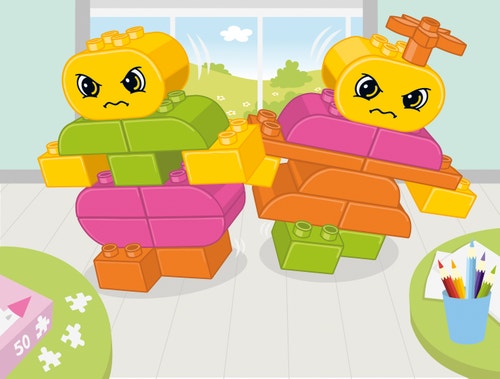Zoey Takes A Stand
Develop an understanding that people have different preferences and dealing with disagreements.

Connect
Tell the children you will read them a story about Zoey and Jeesun.
Explain that Zoey usually does what her friends want to do, but in this story, she wants to do something different from what Jeesun wants to do. This upsets Jeesun.
Show the children the illustration for this lesson.

Read the following story aloud:
Mrs. Muffin says that Jeesun and her friend Zoey are like two peas in a pod. They both bought the same kind of backpack and the same new shoes for the start of preschool. They planned which matching ribbons they would wear in their ponytails on Mondays. They always sat together at snack time. Every day during free choice time, they would rush off hand-in-hand to the creator space where they would spend their whole time making books for their moms.
One day, after circle time, Zoey and Jeesun held hands to go to the creator space as they always did. But today, Jeesun felt Zoey pull her in a different direction. Zoey said that she wanted to go to the puzzle and games center for a change.
Jeesun was surprised that Zoey would even suggest this.
You can’t make books for moms in the puzzle and games center. You can’t make anything to keep! Puzzles can take forever, sometimes the entire free choice time. Jeesun thought.
Zoey, however was not changing her mind. She likes to sit quietly and do puzzles. Besides, her mom has a stack of books she had made for her last week. Zoey urged Jeesun to try it one time and gently pulled her by the hand closer to the puzzle and games center. Well, Jeesun was just not having it. She yanked her hand out of Zoey’s, put her hands on her hips, and stomped away confused that Zoey would want to try something new. Puzzles and games center, this is just not what they do!
Zoey and Jeesun, who usually agree on everything, didn’t see eye to eye in this situation. Zoey wasn’t sure what to do. She went to find Mrs. Muffin and asked for help.
Consider asking questions like:
- What do you think Mrs. Muffin suggested to Zoey?
- What could be done to resolve the conflict?
- Do you have a close friend who likes things that you don’t like?
- Does this ever cause a problem?
Construct
Ask the children to work with a building buddy to build something that one of them likes. (Specify that this should not include real people.)
Then ask them to build something that one of them doesn’t like. (Specify that this should not include real people.)
Activity tip: in order to guide the building process and to be able to compare likes
and dislikes, suggest building categories (e.g., food, toys, animals, something at
preschool, something in your bedroom, or book characters.)
Contemplate
Ask the building buddies to share their models with the class. Ask the children to explain their reasoning for why they like or dislike the things they have built models of.
Assist them in noticing similarities and differences among other children in the group, especially peers who are good friends. Tell the children that we respect each other’s likes and dislikes even when they are different from our own.
Continue
Print the Likes and Dislikes Table.

Ask the children to think of something they would like to ask their classmates if they like or dislike.
When the group has decided on a topic, fill in the blank at the top of the page by either drawing a picture or cutting and pasting a picture.
Tell the children to find their own names and place a checkmark to show whether they like or dislike the topic shown in the picture above the table.
After everyone has responded, discuss the results as a group.
The children could use the Likes and Dislikes Table to collect data during free choice time. This also might be a nice home-link activity to use with family members.
Teacher tip: Use clipboards so the children can easily navigate around the room. This
also allows for several children to poll on various topics at a time.
Did you notice?
Observing the following skills can help you monitor whether the children are developing socially and emotionally.
- Children are able to identify personal preferences.
- Children are able to understand other people’s feelings.
교사 지원
Children will :
Understand that people have different likes and dislikes.
Understand that it is okay to prefer something different from what a friend prefers.
Children are able to understand other people’s feelings.
Children are able to identify personal preferences.




